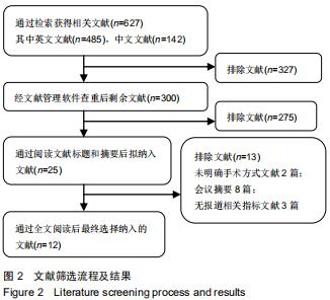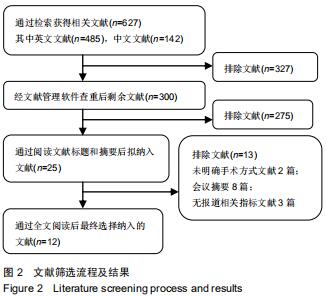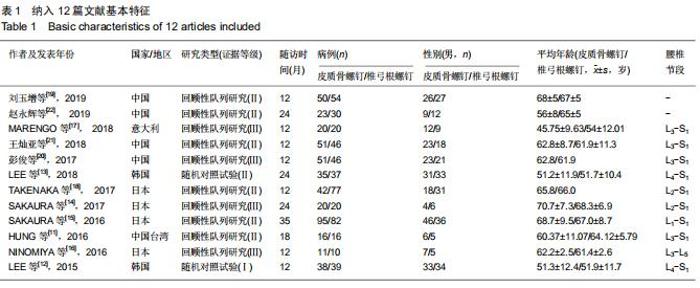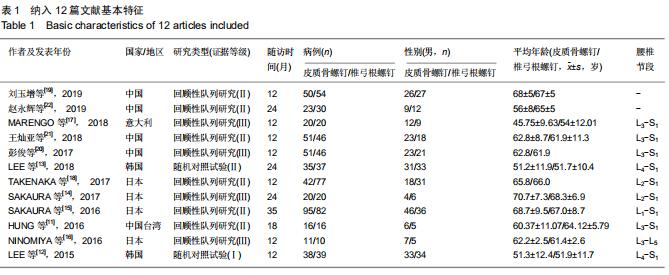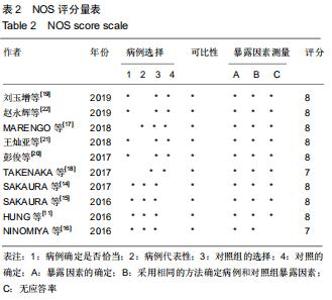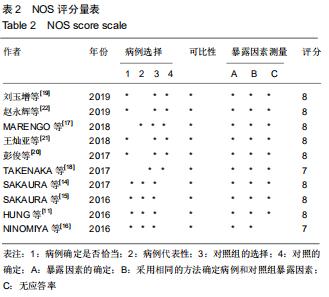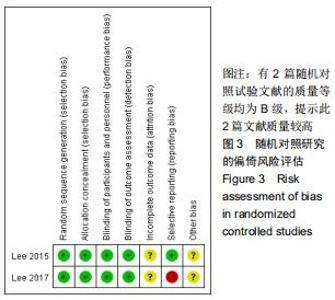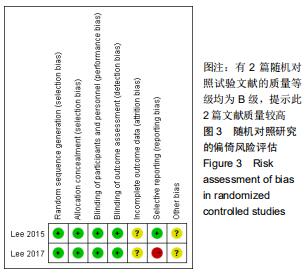Chinese Journal of Tissue Engineering Research ›› 2020, Vol. 24 ›› Issue (36): 5871-5879.doi: 10.3969/j.issn.2095-4344.2911
Previous Articles Next Articles
Comparative clinical efficacy of cortical bone trajectory screw and pedicle screw fixation in posterior lumbar interbody fusion: a meta‑analysis
Chen Haoyan, Xiao Zenglin, Wang Dongping, Xie Weixing, Jin Daxiang
- First Clinical Medical College of Guangzhou University of Chinese Medicine, Guangzhou 510405, Guangdong Province, China
-
Received:2020-03-03Revised:2020-03-11Accepted:2020-04-18Online:2020-12-28Published:2020-10-27 -
Contact:Jin Daxiang, Chief physician, The First Affiliated Hospital of Guangzhou University of Chinese Medicine, Guangzhou 510405, Guangdong Province, China -
About author:Chen Haoyan, Master candidate, First Clinical Medical College of Guangzhou University of Chinese Medicine, Guangzhou 510405, Guangdong Province, China -
Supported by:the Science and Technology Planning Project of Guangdong Province, No. 2016A020226007
CLC Number:
Cite this article
Chen Haoyan, Xiao Zenglin, Wang Dongping, Xie Weixing, Jin Daxiang. Comparative clinical efficacy of cortical bone trajectory screw and pedicle screw fixation in posterior lumbar interbody fusion: a meta‑analysis[J]. Chinese Journal of Tissue Engineering Research, 2020, 24(36): 5871-5879.
share this article
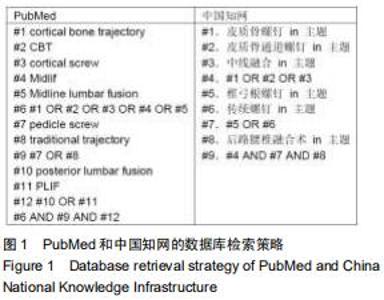
1.1 文献检索 由2位研究者分别进行文献收集。计算机浏览器检索PubMed、Embase、Web of Science、中国生物医学系统(CBM)、中国知网(CNKI)和万方数据库,检索时间均设为2009年至2020年1月。英文数据库英文检索词包括:“CBT,cortical bone trajectory,Midlif,cortical screw,Pedicle Screw,traditional trajectory,posterior lumbar fusion,PLIF”。中文数据库中文检索词包括:“皮质骨螺钉、中线融合、椎弓根螺钉、腰椎融合术”。最后2位研究员对收集结果进行交叉核对,对于文献中缺少的数据尽量与作者联系予以补充。PubMed和中国知网的数据库检索策略见图1。 "
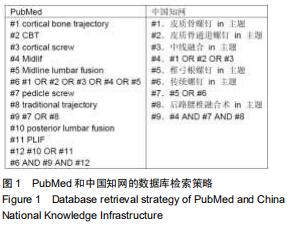
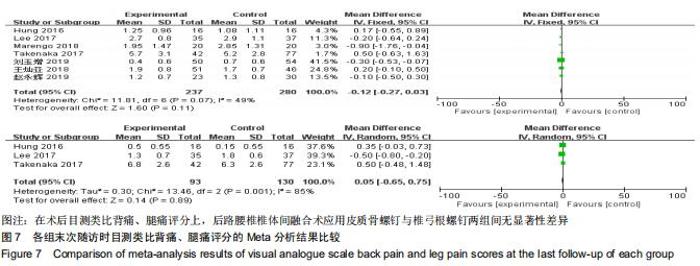
2.3.4 各组术后目测类比评分:有7篇文献报道了二者术后的目测类比背痛评分[11,13,17-19,21-22],异质性检验提示中度异质性(I2=49%)。采用固定效应模型进行合并效应量检验,二者在目测类比背痛评分无显著差异(MD=-0.12,95%CI:-0.27-0.03,P=0.11);有3篇文献报道了二者术后目测类比腿痛评分[11,13-14],异质性检验提示存在高度异质性(I2=85%)。采用随机效应模型进行合并效应量检验,二者在目测类比腿痛评分无明显差异(MD=0.05,95%CI:-0.65-0.75,P=0.89)。结果表明,与椎弓根螺钉固定比较,应用皮质骨螺钉行后路腰椎椎间融合术在术后目测类比背痛、腿痛评分上无显著差异,见图7。 "
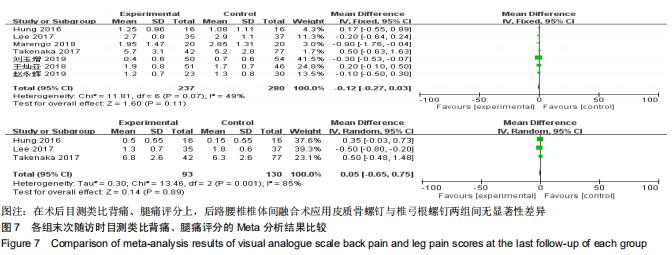

2.3.5 各组术后Oswestry功能障碍指数问卷表、JOA评分有6篇文献报道了二者术后随访的Oswestry功能障碍指数问卷表评分[11,13,17,19-21],异质性检验提示存在高度异质性(I2=74%),采用随机效应模型,合并效应量检验表明二者在术后Oswestry功能障碍指数问卷表评分无明显差异(MD=-1.95,95%CI:-4.11-0.20,P=0.08);有4篇文章报道了二者术后随访的JOA评分[11,14-15,22],异质性检验提示低异质性(I2=0%)。采用固定效应模型进行合并效应量检验,二者在术后JOA评分无明显差异(MD=0.47,95%CI:-0.24-1.19,P=0.19)。结果表明,与椎弓根螺钉固定比较,应用皮质骨螺钉行后路腰椎椎间融合术在术后Oswestry功能障碍指数问卷表、JOA评分上无显著差异,见图8,9。 "


2.3.5 各组术后Oswestry功能障碍指数问卷表、JOA评分有6篇文献报道了二者术后随访的Oswestry功能障碍指数问卷表评分[11,13,17,19-21],异质性检验提示存在高度异质性(I2=74%),采用随机效应模型,合并效应量检验表明二者在术后Oswestry功能障碍指数问卷表评分无明显差异(MD=-1.95,95%CI:-4.11-0.20,P=0.08);有4篇文章报道了二者术后随访的JOA评分[11,14-15,22],异质性检验提示低异质性(I2=0%)。采用固定效应模型进行合并效应量检验,二者在术后JOA评分无明显差异(MD=0.47,95%CI:-0.24-1.19,P=0.19)。结果表明,与椎弓根螺钉固定比较,应用皮质骨螺钉行后路腰椎椎间融合术在术后Oswestry功能障碍指数问卷表、JOA评分上无显著差异,见图8,9。 "

|
[1] GAINES RW. The use of pedicle-screw internal fixation for the operative treatment of spinal disorders. J Bone Joint Surg Am. 2000;82(10):1458-1476.
[2] RANTANEN J, HURME M, FALCK B, et al. The lumbar multifidus muscle five years after surgery for a lumbar intervertebral disc herniation. Spine.1993;18(5):568-574.
[3] EL SAMAN A, MEIER S, SANDER A, et al. Reduced loosening rate and loss of correction following posterior stabilization with or without PMMA augmentation of pedicle screws in vertebral fractures in the elderly. Eur J Trauma Emerg Surg. 2013;39(5):455-460.
[4] SANTONI BG, HYNES RA, MCGILVRAY KC, et al. Cortical bone trajectory for lumbar pedicle screws. Spine J. 2009; 9(5):366-373.
[5] MATSUKAWA K, YATO Y, KATO T, et al. In vivo analysis of insertional torque during pedicle screwing using cortical bone trajectory technique. Spine. 2014;39(4):E240-E245.
[6] 王亮,李立军,朱福良,等.皮质骨通道螺钉与椎弓根螺钉固定用于后路腰椎椎体间融合的Meta分析[J].中国组织工程研究,2019, 23(8):1291-1298.
[7] WANG J, HE X, SUN T. Comparative clinical efficacy and safety of cortical bone trajectory screw fixation and traditional pedicle screw fixation in posterior lumbar fusion: a systematic review and meta-analysis. Eur Spine J. 2019;28(7):1678-161689.
[8] ZHANG T, GUO N, CHEN T, et al. Comparison of outcomes between cortical screws and traditional pedicle screws for lumbar interbody fusion: a systematic review and meta-analysis. J Orthop Surg Res. 2019;14(1):269.
[9] KEOROCHANA G, PAIRUCHVEJ S, TRATHITEPHUN W, et al. Comparative outcomes ofcortical screw trajectory fixation and pedicle screw fixation in lumbar spinal fusion:systematic review and meta-analysis. World Neurosurg. 2017;102: 340-349.
[10] STANG A. Critical evaluation of the Newcastle-Ottawa scale for the assessment of the quality of nonrandomized studies in meta-analyses. Eur J Epidemiol. 2010;25(9):603-605.
[11] HUNG CW, WU MF, HONG RT, et al. Comparison of multifidus muscle atrophy after posterior lumbar interbody fusion with conventional and cortical bone trajectory. Clin Neurol Neurosur. 2016;145:41-45.
[12] LEE GW, SON JH, AHN MW, et al. The comparison of pedicle screw and cortical screw in posterior lumbar interbody fusion: a prospective randomized noninferiority trial. Spine J. 2015; 15(7):1519-1526.
[13] LEE GW, AHN MW. Comparative study of cortical bone trajectory-pedicle screw (cortical screw) versus conventional pedicle screw in single-level posterior lumbar interbody fusion: a 2-year post hoc analysis from prospectively randomized data. World Neurosurg. 2018;109:e194-e202.
[14] SAKAURA H, MIWA T, YAMASHITA T, et al. Cortical bone trajectory screw fixation versus tradi-tional pedicle screw fixation for 2-level posterior lumbar interbody fusion: comparison of surgical outcomes for 2-level degenerative lumbar spondylolisthesis. J Neurosurg Spine. 2018;28(1):57-62.
[15] SAKAURA H, MIWA T, YAMASHITA T, et al. Posterior lumbar interbody fusion with cortical bone trajectory screw fixation versus posterior lumbar interbody fusion using traditional pedicle screw fixation for degenerative lumbar spondylolisthesis: a comparative study. J Neurosurg Spine. 2016;25(5):591-595.
[16] NINOMIYA K, IWATSUKI K, OHNISHI Y, et al. Radiological evaluation of the initial fixation be-tween cortical bone trajectory and conventional pedicle screw technique for lumbar degenerative spondylolisthesis. Asian spine J. 2016;10(2):251-257.
[17] MARENGO N, AJELLO M, PECORARO MF, et al. Cortical bone trajectory screws in posterior lumbar interbody fusion: minimally invasive surgery for maximal muscle sparing-a prospective comparative study with the traditional open technique. Biomed Res Int. 2018;2018:7424568.
[18] TAKENAKA S, MUKAI Y, TATEISHI K, et al. Clinical outcomes after posterior lumbar interbody fusion: comparison of cortical bone trajectory and conventional pedicle screw insertion. Clin Spine Surg. 2017;30(10):E1411-E1418.
[19] 刘玉增,海涌,张希诺,等.皮质骨轨迹螺钉固定与椎弓根螺钉固定在腰椎后路融合术中的疗效[J].中华医学杂志,2019,99(19): 1473-1478.
[20] 彭俊,詹玉林,刘英杰,等.皮质骨通道螺钉与椎弓根螺钉行腰椎后路椎间融合的疗效比较[J].中国修复重建外科杂志,2017,31(11): 1341-1345.
[21] 王灿亚,袁宏伟,田志红.皮质骨通道螺钉与椎弓根螺钉行腰椎间融合术的疗效比较[J].临床骨科杂志,2018,21(4):444-447.
[22] 赵永辉,陆声,马宇龙,等.皮质骨通道螺钉技术在腰椎退变性疾病中的临床应用[J].中华老年骨科与康复电子杂志,2019,5(3): 123-129.
[23] RAJAEE SS, BAE HW, KANIM LE, et al. Spinal fusion in the United States: analysis of trends from 1998 to 2008. Spine. 2012;37(1):67-76.
[24] MOBBS RJ. The "medio-latero-superior trajectory technique": an alternative cortical trajectory for pedicle fixation. Orthop Surg. 2013;5(1):56-59.
[25] MATSUKAWA K, YATO Y, NEMOTO O, et al. Morphometric measurement of cortical bone trajec-tory for lumbar pedicle screw insertion using computed tomography. J Spinal Disord Tech. 2013;26(6):E248-E253.
[26] KASUKAWA Y, MIYAKOSHI N, HONGO M, et al. Short-term results of transforaminal lumbar interbody fusion using pedicle screw with cortical bone trajectory compared with conventional trajectory. Asian Spine J. 2015;9(3):440-448. [27] GLENNIE RA, DEA N, KWON BK, et al. Early clinical results with cortically based pedicle screw trajectory for fusion of the degenerative lumbar spine. J Clin Neurosci. 2015;22(6): 972-975.
[28] PATEL SS, CHENG WK, DANISA OA. Early complications after instrumentation of the lumbar spine using cortical bone trajectory technique. J Clin Neurosci. 2016;24:63-67.
[29] GAO H, ZHANG R, JIA C, et al. Novel placement of cortical bone trajectory screws in the lumbar spine: a radiographic and cadaveric study. Clin Spine Surg. 2018;31(6):E329-E336.
[30] SENOGLU M, KARADAG A, KINALI B, et al. Cortical bone trajectory screw for lumbar fixation: a quantitative anatomic and morphometric evaluation. world neurosurg. 2017;103: 694-701.
[31] LE X, TIAN W, SHI Z, et al. Robot-assisted versus fluoroscopyassisted cortical bone trajectory screw instrumentation in lumbar spinal surgery: a matched-cohort comparison. World Neurosurg. 2018;120:e745-e751.
[32] KAITO T, MATSUKAWA K, ABE Y, et al. Cortical pedicle screw placement in lumbar spinal surgery with a patient-matched targeting guide: a cadaveric study. J Orthop Sci. 2018;23(6):865-869.
[33] PENNER F, MARENGO N, AJELLO M, et al. Preoperative 3D CT planning for cortical bone tra-jectory screws: a retrospective radiological cohort study. World Neurosurg. 2019;126:e1468-e1474.
[34] 杨民毅,刘西纺,刘世长,等.皮质骨螺钉通道技术在骨质疏松腰椎退行性疾病中的应用[J].实用骨科杂志,2019,25(3):245-249.
[35] 杨再超,陈建,田进财,等.皮质骨螺钉固定技术在腰椎管狭窄症术后邻椎病手术中的应用[J].临床医药文献电子杂志,2019,6(88): 57-58.
[36] UENO M, IMURA T, INOUE G, et al. Posterior corrective fusion using a doubletrajectory technique (cortical bone trajectory combined with traditional trajectory) for degenerative lumbar scoliosis with osteoporosis: technical note. J Neurosurg Spine.2013;19(5):600-607.
[37] COFANO F, MARENGO N, AJELLO M, et al. The era of cortical bone trajectory screws in spine surgery: a qualitative review with rating of evidence. World Neurosurg.2020;134: 14-24.
[38] FENG Z, LI X, TANG Q, et al. Transforaminal lumbar interbody fusion with cortical bone trajectory screws versus traditional pedicle screws fixation: a study protocol of randomised controlled trial. BMJ Open. 2017;7(10):e017227.
[39] TSCHUGG A, KAVAKEBI P, HARTMANN S, et al. Clinical and radiological effect of medialized cortical bone trajectory for lumbar pedicle screw fixation in patients with degenerative lumbar spondylolisthesis: study protocol for a randomized controlled trial (mPACT). Trials. 2018;19(1):129. [40] ZHANG TX, GUO NN, CHEN TT, et al. Comparison of outcomes between cortical screws and traditional pedicle screws for lumbar interbody fusion: a systematic review and meta-analysis. J Orthop Surg Res. 2019;14:269. |
| [1] | . Changes in Lumbosacral Sagittal Plane Parameters of L5/S1 Disc Herniation [J]. Chinese Journal of Tissue Engineering Research, 2023, 27(在线): 1-6. |
| [2] | Zhong Yizheng, Huang Peizhen, Cai Qunbin, Zheng Liqin, He Xingpeng, Dong Hang. Microstructural indexes that determine the trabecular bone maximum stress of micro-finite element models [J]. Chinese Journal of Tissue Engineering Research, 2023, 27(9): 1313-1318. |
| [3] | Wu Taoguang, Nie Shaobo, Chen Hua, Zhu Zhengguo, Qi Lin, Tang Peifu. Biomechanical characteristics of a new multi-dimensional cross locking plate in the treatment of subtrochanteric nonunion [J]. Chinese Journal of Tissue Engineering Research, 2023, 27(9): 1330-1334. |
| [4] | Peng Zhixin, Yan Wengang, Wang Kun, Zhang Zhenjiang. Finite element analysis and structural optimization design of 3D printed forearm braces [J]. Chinese Journal of Tissue Engineering Research, 2023, 27(9): 1340-1345. |
| [5] | Wu Tianliang, Tao Xiuxia, Xu Hongguang. Influence of different bone mineral densities on cage subsidence after stand-alone oblique lateral interbody fusion: three-dimensional finite element analysis [J]. Chinese Journal of Tissue Engineering Research, 2023, 27(9): 1352-1358. |
| [6] | He Yujie, Kang Zhijie, Xue Mingming, Jin Feng, Li Zhijun, Wang Xing, Xu Yangyang, Gao Mingjie, Li Jiawei, Li Xiaohe, Wang Haiyan. Finite element analysis of transarticular screw fixation of adolescent thoracic vertebra [J]. Chinese Journal of Tissue Engineering Research, 2023, 27(9): 1365-1370. |
| [7] | Wen Xinghua, Ding Huanwen, Cheng Kai, Yan Xiaonan, Peng Yuanhao, Wang Yuning, Liu Kang, Zhang Huiwu. Three-dimensional finite element model analysis of intramedullary nailing fixation design for large femoral defects in Beagle dogs [J]. Chinese Journal of Tissue Engineering Research, 2023, 27(9): 1371-1376. |
| [8] | Zheng Hongrui, Zhang Wenjie, Wang Yunhua, He Bin, Shen Yajun, Fan Lei. Femoral neck system combined with platelet-rich plasma in the treatment of femoral neck fracture [J]. Chinese Journal of Tissue Engineering Research, 2023, 27(9): 1390-1395. |
| [9] | You Zhengqiu, Zhang Zhongzu, Wang Qunbo. Early symptomatic intervertebral disc pseudocysts after discectomy detected on MRI [J]. Chinese Journal of Tissue Engineering Research, 2023, 27(9): 1403-1409. |
| [10] | Zheng Bo, Zhang Xiuli, Zhou Hao, He Zebi, Zhou Jin, Zhou Weiyun, Li Peng. Arthroscopy-assisted locking hollow screw fixation and open reduction plate internal fixation in the treatment of Schatzker II-III tibial plateau fractures: early CT evaluation [J]. Chinese Journal of Tissue Engineering Research, 2023, 27(9): 1410-1416. |
| [11] | Li Chao, Zhang Peipei, Xu Mengting, Li Linlin, Ding Jiangtao, Liu Xihua, Bi Hongyan. Respiratory training improves morphological changes of the multifidus muscle in patients with chronic nonspecific lower back pain assessed by musculoskeletal ultrasound [J]. Chinese Journal of Tissue Engineering Research, 2023, 27(9): 1417-1421. |
| [12] | Dang Yi, Du Chengyan, Yao Honglin, Yuan Nenghua, Cao Jin, Xiong Shan, Zhang Dingmei, Wang Xin. Hormonal osteonecrosis and oxidative stress [J]. Chinese Journal of Tissue Engineering Research, 2023, 27(9): 1469-1476. |
| [13] | Wang Yanjin, Zhou Yingjie, Chai Xubin, Zhuo Hanjie. Meta-analysis of the efficacy and safety of 3D printed porous titanium alloy fusion cage in anterior cervical discectomy and fusion [J]. Chinese Journal of Tissue Engineering Research, 2023, 27(9): 1434-1440. |
| [14] | Jiang Xiaocheng, Shi Lu, Wang Yinbin, Li Qiujiang, Xi Chuangzhen, Ma Zefeng, Cai Lijun. Systematical evaluation of bone fusion rate after interbody fusion in patients with osteoporosis and lumbar degenerative disease treated with teriparatide [J]. Chinese Journal of Tissue Engineering Research, 2023, 27(9): 1427-1433. |
| [15] | Yang Zhishan, Tang Zhenglong. YAP/TAZ, a core factor of the Hippo signaling pathway, is involved in bone formation [J]. Chinese Journal of Tissue Engineering Research, 2023, 27(8): 1264-1271. |
| Viewed | ||||||
|
Full text |
|
|||||
|
Abstract |
|
|||||
